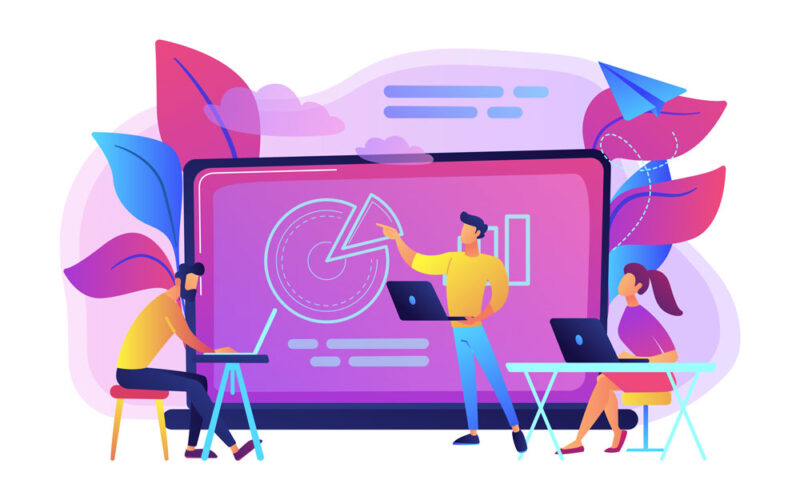Blended learning is already a concept that has existed since the mid-1990s. Still, many educational institutions worldwide have become more interested in blended learning after many changes due to the pandemic over the past two years, and many are running various programs with blended learning as their main educational system. Let’s look at the differences between existing educational methods and blended learning, how they use in various models in the actual academic field, and what pros and cons they have.
What is blended learning?
Blended learning is a combination of traditional teaching and learning methods and remote teaching methods that use techniques such as the Internet, voice email, and video conferencing (Smiths, 2001). In addition, Horton (2009) defined blended learning as combining the advantages of face-to-face learning with the benefits of web-based learning for the need for learning.
In addition, blended learning is the most effective way to achieve successful learning outcomes by utilizing the technology of computers and the Internet, increasing student engagement, and improving independence and achievement with an emphasis on the relationship between teachers and students (Wilson & Smilanche, 2004).
In other words, in mixed learning, mixing does not mean just technology but also includes real-world experiences (LaBanca et al. 2013).
Blended Learning Models
1. Rotation
It is a form of moving from one learning to another by conducting online learning in a self-directed manner or in a systematic learning method guided by a teacher before learners attend face-to-face education.
2. Online practice
This method strengthens and integrates learning but has no or little interaction with instructors. Learners are in a completely digital form by accessing the contents of tablets, laptops, and mobile phones.
3. Self-blend
Self-blend is additional content provided in the form of video tutorials to help learners themselves explore a particular topic, making it possible to use sources such as industry blogs, zoom, webinars, and white papers. These different contents lead learners to grow up with an interest in more diverse things.
4. Online drivers
It is conducted entirely online in a self-directed form of learning, and learners interact with instructors through email, chat, and message boards. There is an advantage in making the flexibility of the learner’s learning schedule and individualized learning provisions.
Pros of blended learning
- Learners can prepare for classes in advance through online learning. In the case of practical mixed knowledge, learners can be more interested in the course by looking at the materials necessary for the course in advance before the face-to-face demonstration and the main topics of the course.
- It helps students take the initiative in learning. Lectures can provide in various times and fields, so learners can create their learning schedules and select courses according to the time they need and can take academic classes and professional classes related to work depending on the current learner’s condition.
- The learning speed can be set according to the level of learners. Learners who have difficulty understanding the content can understand it by looking at the difficult parts several times according to the level of learning, and learners who understand it can proceed with the class at a faster pace, thereby increasing the learning efficiency.
- Learners can have the opportunity to learn, and experience various software, hardware, and new skills used in blended learning. These experiences will help learners prepare the skills to learn in the future and demonstrate their capabilities better.
Cons of blended learning
- blended learning is a form of learning that is difficult to apply to learners who are not familiar with self-directed learning or have difficulty understanding classes with online materials because there is not much interaction with instructors, and most of the materials are online.
- For learners who lack knowledge of blended learning or whose digital use is not routine, an appropriate level of support or prior education on technology-based learning is required.
- If schools or educational institutions have mainly conducted face-to-face learning, it may be not easy to convert the environment to blended learning. There may be time constraints and difficulties in infrastructure preparation, such as the preparation of necessary training materials and materials, various settings for online transition, and logistics.
Conclusion
Yan and Lee (2011) argue that “blended learning, which carefully combines the best elements of online and face-to-face education, is likely to emerge as a dominant educational model in the future.” (p.138). Through the unprecedented pandemic, many people, including the education community, are looking at education. Education is no longer about going to school at a fixed time every day to fill a given amount of learning. Already, many innovative educators in higher education and corporate learning are actively adopting a blended learning model through technology support by quickly establishing a learning infrastructure through various technologies and software hardware. Through the many advantages of blended learning, learners can learn, experience, and develop more through classes.
References
- Ceylan, V.K. and Kesici, A.E., 2017. Effect of blended learning to academic achievement. Journal of Human Sciences, 14(1), pp.308-320.
- Çiftçi, B., 2020. The Effect of Blended Learning on Academic Achievement and Attitudes at Social Studies Courses. Open Journal for Educational Research, 4(2), pp.143-150.
- ELM Learning, 2022. What is Blended Learning? A Guide to Everything You Need to Know. [online] Available at: https://elmlearning.com/blog/blended-learning-everything-need-know/ [Accessed 15 June 2022].
- Poon, Joanna, 2013, Blended learning: an institutional approach for enhancing students’ learning experiences. Journal of online learning and teaching, 9(2), pp. 271-288.
- Sarah LillyWhite, 2021. Everything you need to know about blended learning. [online] Available at: https://www.futurelearn.com/info/blog/everything-about-blended-learning [Accessed 18 June 2022].
- Vasileva-Stojanovska, T., Malinovski, T., Vasileva, M., Jovevski, D. and Trajkovik, V., 2015. Impact of satisfaction, personality and learning style on educational outcomes in a blended learning environment. Learning and Individual Differences, 38, pp.127-135.
